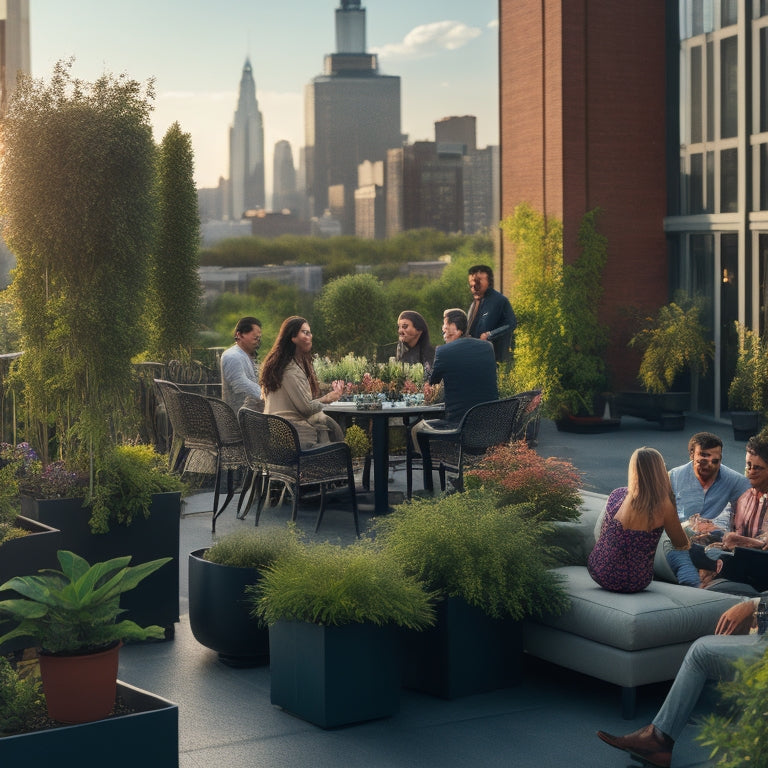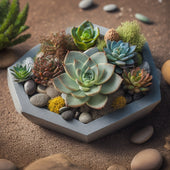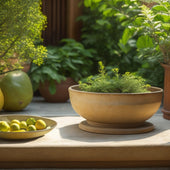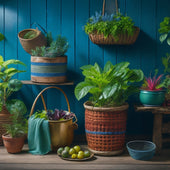
Top Vertical Gardening Systems for Rooftop Success
Share
You're transforming your rooftop into a thriving oasis, and selecting the right vertical gardening system is essential to achieving success in even the smallest of spaces. To maximize your rooftop's potential, consider trellis-based systems that provide ideal plant support, modular wall gardens for customizable layouts, or hydroponic towers that increase crop yields. Pocket planters offer flexibility, while irrigation systems in modular design ensure efficient water distribution. Lastly, vertical green walls improve air quality and aesthetic appeal. By choosing the right system, you'll access the full potential of your rooftop oasis - and that's just the starting point for your vertical gardening journey.
Rooftop Space Savers
By exploiting the often-underutilized rooftop area, you can maximize your property's spatial efficiency with vertical gardening systems that integrate seamlessly into existing architecture. This approach allows you to create a thriving urban oasis, perfect for relaxation and entertainment.
With container gardening, you can transform small spaces into a lush rooftop retreat, complete with vibrant greenery and colorful blooms.
When selecting a vertical gardening system, consider the weight capacity of your rooftop and choose a system that distributes weight evenly. Modular systems are ideal for small spaces, as they can be easily expanded or rearranged as needed.
Additionally, look for systems with built-in irrigation and drainage, ensuring your plants receive the right amount of water and nutrients.
Trellis-Based Systems
When you're designing a trellis-based system for your rooftop garden, you'll need to contemplate the plant support options that will work best for your specific crops.
You'll want to select a system that allows for maximum space utilization, such as a vertical trellis or an oblique trellis, to make the most of your rooftop real estate.
Plant Support Options
You'll need to choose a trellis-based system that provides ideal plant support, considering factors such as plant type, growth habits, and weight capacity to guarantee a thriving rooftop garden.
For climbing vines, wire frames with a sturdy structure and sufficient spacing are essential. These frames allow vines to grow upward, maximizing vertical space while keeping the weight of the plants evenly distributed.
Alternatively, you can use bamboo stakes or tomato cages to provide support for individual plants. Bamboo stakes are ideal for smaller plants, while tomato cages are better suited for larger, heavier plants.
When selecting a trellis-based system, consider the material, durability, and adjustability. Look for systems with a rust-resistant coating, UV-stabilized materials, and adjustable heights to accommodate different plant varieties.
Additionally, make sure the system is easy to assemble, disassemble, and clean to minimize maintenance.
Space Maximization Strategies
To optimize rooftop garden space, trellis-based systems employ strategic layering and arrangement techniques that enable growers to cultivate multiple tiers of plants within a single vertical plane. By doing so, you can increase space utilization while maintaining easy access to each plant.
Hanging planters, for instance, can be suspended from the trellis framework, allowing you to make the most of overhead space. This approach not only maximizes vertical growth but also creates a visually appealing display.
Ladder style racks are another effective way to optimize space. These racks feature horizontal rungs that allow you to train vines or climbing plants to grow upwards, making efficient use of vertical space. The ladder design also adds an aesthetic appeal to your rooftop garden, creating a sense of depth and texture.
Easy Training Methods
By incorporating simple training methods into your trellis-based system, such as gently twisting stems around supports or using gentle ties to secure climbing plants, you can effortlessly guide your plants' growth and promote healthy development. This approach allows for precise control over plant care, ensuring best watering techniques and sunlight exposure. Proper plant placement is also vital, as it affects the overall aesthetic and productivity of your rooftop garden.
Here are three essential tips to keep in mind:
-
** Train plants in a way that maximizes sunlight exposure**: By training your plants to grow upwards or outwards, you can ensure they receive the necessary amount of sunlight for best growth.
-
** Use gentle ties to secure climbing plants**: Gentle ties won't damage your plants' stems, allowing them to grow freely while still providing support.
-
** Monitor and adjust plant placement regularly**: As your plants grow, adjust their placement to ensure even sunlight distribution and prevent overcrowding.
Modular Wall Gardens
Modular wall gardens, comprising multiple units or panels, offer a highly customizable and space-efficient solution for rooftop gardens, allowing designers to tailor the system's size and layout to fit specific site conditions and plant selection.
With DIY customization, you can create an urban oasis design that suits your unique needs and vision. By combining multiple panels, you can achieve a larger garden area while maintaining a sleek, modern aesthetic.
When selecting a modular wall garden system, look for sustainable materials that can withstand harsh weather conditions. Durable materials like recycled plastic, aluminum, or stainless steel guarantee your system remains intact even in extreme weather.
Weather resistance is essential, as rooftop gardens are exposed to direct sunlight, heavy rainfall, and strong winds. A well-designed modular wall garden system won't only thrive in these conditions but also provide a lush, verdant oasis in the midst of the urban landscape.
Hydroponic Towers
You can maximize rooftop space with hydroponic towers, which use a soilless growing method to support a high density of plants in a compact, vertical arrangement. This makes them ideal for urban agriculture, where space is often limited.
By using hydroponic towers, you can increase crop yields while minimizing water and land usage, making them a sustainable farming solution.
Here are three key benefits of hydroponic towers:
-
Increased crop yields: Hydroponic towers can support up to 30 plants per square foot, making them a highly productive option for rooftop gardens.
-
Water efficiency: Hydroponic systems use up to 90% less water than traditional farming methods, making them an attractive option for water-conscious urban farmers.
-
Year-round production: With hydroponic towers, you can control the growing conditions, allowing you to produce crops year-round, regardless of the season.
Pocket Planters
When you're designing a pocket planter system for your rooftop garden, you'll need to take into account the soil depth requirements for your chosen plants.
This is important because pockets with inadequate soil depth can lead to root bound plants, reducing their overall health and productivity.
Soil Depth Matters
In pocket planters, the soil depth is vital, as it directly impacts the root development and overall health of the plants, with a minimum of 5-7 inches typically recommended for best growth.
When you're designing your rooftop garden, it's important to consider the soil depth to make sure your plants receive the necessary nutrients and water retention.
Here are three key aspects to think about for the best soil depth:
-
Root development: A deeper soil depth allows for more extensive root growth, which is important for plant nutrition and overall plant health.
-
Water retention: A minimum of 5-7 inches of soil depth helps retain water, reducing the need for frequent watering and minimizing water waste.
-
Oxygen availability: Adequate soil depth ensures that roots receive sufficient oxygen, promoting healthy growth and preventing root rot.
Modular Design Benefits
By incorporating modular pocket planters into your rooftop garden design, you can reap numerous benefits, including increased flexibility, improved accessibility, and enhanced overall aesthetics. With customizable layouts, you can create a unique and functional space that suits your specific needs. Modular pocket planters allow you to arrange and rearrange your plants as needed, making it easy to adjust to changing conditions or experiment with new layouts.
Efficient irrigation systems can be easily integrated into your modular design, ensuring that your plants receive the right amount of water without waste. This not only saves resources but also reduces maintenance tasks.
Versatile configurations enable you to create a rooftop garden that fits your available space, whether it's a small balcony or a large rooftop. Plus, quick installation means you can get started on your project right away, without lengthy setup times.
With modular pocket planters, you have complete control over your rooftop garden's design and functionality, allowing you to create a thriving oasis that meets your specific needs and goals.
Vertical Green Walls
You'll achieve maximum rooftop space efficiency with vertical green walls, which involve training vines or plants to grow upwards on a trellis or wall-mounted system. This setup not only maximizes space but also provides numerous benefits.
For instance, vertical green walls are known for their air purification properties, which can markedly improve indoor air quality. Additionally, they add an aesthetic appeal to your rooftop, making it a visually stunning space.
Here are three key advantages of vertical green walls:
-
Improved air quality: Vertical green walls can remove pollutants and toxins from the air, creating a healthier environment for you and your guests.
-
Increased aesthetic appeal: These walls can be designed to be visually striking, adding a unique touch to your rooftop space.
-
Indoor application flexibility: Vertical green walls can be installed indoors, making them a great option for DIY projects or small spaces.
Frequently Asked Questions
How Do I Ensure My Rooftop Garden Can Withstand High Winds?
To guarantee your rooftop garden withstands high winds, you'll need wind-resistant structures, such as reinforced planters or trellises, and employ anchoring techniques like guy wires or weighted bases to secure your garden's infrastructure.
Are Vertical Gardening Systems Suitable for Rooftop Spaces With Limited Sunlight?
You'll find that vertical gardening systems can thrive in rooftop spaces with limited sunlight by incorporating shade solutions, such as trellises or canopies, and exploring creative alternatives like grow lights or reflective surfaces.
Can I Use a Vertical Garden to Grow Vegetables and Fruits?
You can definitely use a vertical garden to grow vegetables and fruits, selecting vertical garden designs that cater to specific fruit and vegetable varieties, such as vining tomatoes or leafy greens, to maximize yields and space efficiency.
How Often Should I Water My Vertical Garden to Prevent Overwatering?
'An ounce of prevention is worth a pound of cure.' You'll want to establish a watering schedule to avoid overwatering, monitoring for signs like yellowing leaves or root rot. Confirm your drainage systems are functioning properly and consider using moisture meters to optimize watering.
Do Vertical Gardens Require More Maintenance Than Traditional Gardens?
You'll find that vertical gardens require more meticulous maintenance than traditional gardens, as you'll need to monitor soil health, implement a precise watering schedule, and prioritize pest control, all while optimizing space utilization to maximize yields.
Related Posts
-

Why Succulents Thrive in DIY Concrete Planters
You've likely noticed that succulents seem to flourish in DIY concrete planters, and it's not just a coincidence - th...
-

Why Succulents Thrive in DIY Concrete Planters
You've likely noticed that succulents seem to flourish in DIY concrete planters, and it's not just a coincidence - th...
-

Why Succulents Thrive in DIY Concrete Planters
You've likely noticed that succulents seem to flourish in DIY concrete planters, and it's not just a coincidence - th...
-

Why Succulents Thrive in DIY Concrete Planters
You've likely noticed that succulents seem to flourish in DIY concrete planters, and it's not just a coincidence - th...
-

Why Succulents Thrive in DIY Concrete Planters
You've likely noticed that succulents seem to flourish in DIY concrete planters, and it's not just a coincidence - th...
-

Why Succulents Thrive in DIY Concrete Planters
You've likely noticed that succulents seem to flourish in DIY concrete planters, and it's not just a coincidence - th...
-

Why Succulents Thrive in DIY Concrete Planters
You've likely noticed that succulents seem to flourish in DIY concrete planters, and it's not just a coincidence - th...
-

Why Succulents Thrive in DIY Concrete Planters
You've likely noticed that succulents seem to flourish in DIY concrete planters, and it's not just a coincidence - th...
-

Why Succulents Thrive in DIY Concrete Planters
You've likely noticed that succulents seem to flourish in DIY concrete planters, and it's not just a coincidence - th...
-

Why Succulents Thrive in DIY Concrete Planters
You've likely noticed that succulents seem to flourish in DIY concrete planters, and it's not just a coincidence - th...
-

Why Succulents Thrive in DIY Concrete Planters
You've likely noticed that succulents seem to flourish in DIY concrete planters, and it's not just a coincidence - th...
-

Why Succulents Thrive in DIY Concrete Planters
You've likely noticed that succulents seem to flourish in DIY concrete planters, and it's not just a coincidence - th...
-

Why Succulents Thrive in DIY Concrete Planters
You've likely noticed that succulents seem to flourish in DIY concrete planters, and it's not just a coincidence - th...
-

Why Succulents Thrive in DIY Concrete Planters
You've likely noticed that succulents seem to flourish in DIY concrete planters, and it's not just a coincidence - th...
-

Why Succulents Thrive in DIY Concrete Planters
You've likely noticed that succulents seem to flourish in DIY concrete planters, and it's not just a coincidence - th...
-

Why Succulents Thrive in DIY Concrete Planters
You've likely noticed that succulents seem to flourish in DIY concrete planters, and it's not just a coincidence - th...
-

Why Succulents Thrive in DIY Concrete Planters
You've likely noticed that succulents seem to flourish in DIY concrete planters, and it's not just a coincidence - th...
-

10 Natural Ways to Clean Your Planters
You can transform your planters from grimy to gleaming with these 10 natural cleaning solutions. Mix baking soda and ...
-

10 Natural Ways to Clean Your Planters
You can transform your planters from grimy to gleaming with these 10 natural cleaning solutions. Mix baking soda and ...
-

10 Natural Ways to Clean Your Planters
You can transform your planters from grimy to gleaming with these 10 natural cleaning solutions. Mix baking soda and ...
-

10 Natural Ways to Clean Your Planters
You can transform your planters from grimy to gleaming with these 10 natural cleaning solutions. Mix baking soda and ...
-

10 Natural Ways to Clean Your Planters
You can transform your planters from grimy to gleaming with these 10 natural cleaning solutions. Mix baking soda and ...
-

10 Natural Ways to Clean Your Planters
You can transform your planters from grimy to gleaming with these 10 natural cleaning solutions. Mix baking soda and ...
-

10 Natural Ways to Clean Your Planters
You can transform your planters from grimy to gleaming with these 10 natural cleaning solutions. Mix baking soda and ...
-

10 Natural Ways to Clean Your Planters
You can transform your planters from grimy to gleaming with these 10 natural cleaning solutions. Mix baking soda and ...
-

10 Natural Ways to Clean Your Planters
You can transform your planters from grimy to gleaming with these 10 natural cleaning solutions. Mix baking soda and ...
-

10 Natural Ways to Clean Your Planters
You can transform your planters from grimy to gleaming with these 10 natural cleaning solutions. Mix baking soda and ...
-

10 Natural Ways to Clean Your Planters
You can transform your planters from grimy to gleaming with these 10 natural cleaning solutions. Mix baking soda and ...
-

10 Natural Ways to Clean Your Planters
You can transform your planters from grimy to gleaming with these 10 natural cleaning solutions. Mix baking soda and ...
-

10 Natural Ways to Clean Your Planters
You can transform your planters from grimy to gleaming with these 10 natural cleaning solutions. Mix baking soda and ...
-

10 Natural Ways to Clean Your Planters
You can transform your planters from grimy to gleaming with these 10 natural cleaning solutions. Mix baking soda and ...
-

10 Natural Ways to Clean Your Planters
You can transform your planters from grimy to gleaming with these 10 natural cleaning solutions. Mix baking soda and ...
-

10 Natural Ways to Clean Your Planters
You can transform your planters from grimy to gleaming with these 10 natural cleaning solutions. Mix baking soda and ...
-

10 Natural Ways to Clean Your Planters
You can transform your planters from grimy to gleaming with these 10 natural cleaning solutions. Mix baking soda and ...
-

10 Natural Ways to Clean Your Planters
You can transform your planters from grimy to gleaming with these 10 natural cleaning solutions. Mix baking soda and ...
-

10 Natural Ways to Clean Your Planters
You can transform your planters from grimy to gleaming with these 10 natural cleaning solutions. Mix baking soda and ...
-

10 Natural Ways to Clean Your Planters
You can transform your planters from grimy to gleaming with these 10 natural cleaning solutions. Mix baking soda and ...
-

10 Natural Ways to Clean Your Planters
You can transform your planters from grimy to gleaming with these 10 natural cleaning solutions. Mix baking soda and ...
-

10 Natural Ways to Clean Your Planters
You can transform your planters from grimy to gleaming with these 10 natural cleaning solutions. Mix baking soda and ...
-

10 Natural Ways to Clean Your Planters
You can transform your planters from grimy to gleaming with these 10 natural cleaning solutions. Mix baking soda and ...
-

10 Natural Ways to Clean Your Planters
You can transform your planters from grimy to gleaming with these 10 natural cleaning solutions. Mix baking soda and ...
-

10 Natural Ways to Clean Your Planters
You can transform your planters from grimy to gleaming with these 10 natural cleaning solutions. Mix baking soda and ...
-

10 Natural Ways to Clean Your Planters
You can transform your planters from grimy to gleaming with these 10 natural cleaning solutions. Mix baking soda and ...
-

10 Natural Ways to Clean Your Planters
You can transform your planters from grimy to gleaming with these 10 natural cleaning solutions. Mix baking soda and ...
-

10 Natural Ways to Clean Your Planters
You can transform your planters from grimy to gleaming with these 10 natural cleaning solutions. Mix baking soda and ...
-

10 Natural Ways to Clean Your Planters
You can transform your planters from grimy to gleaming with these 10 natural cleaning solutions. Mix baking soda and ...
-

10 Natural Ways to Clean Your Planters
You can transform your planters from grimy to gleaming with these 10 natural cleaning solutions. Mix baking soda and ...
-

10 Natural Ways to Clean Your Planters
You can transform your planters from grimy to gleaming with these 10 natural cleaning solutions. Mix baking soda and ...
-

10 Natural Ways to Clean Your Planters
You can transform your planters from grimy to gleaming with these 10 natural cleaning solutions. Mix baking soda and ...
-

10 Natural Ways to Clean Your Planters
You can transform your planters from grimy to gleaming with these 10 natural cleaning solutions. Mix baking soda and ...
-

10 Natural Ways to Clean Your Planters
You can transform your planters from grimy to gleaming with these 10 natural cleaning solutions. Mix baking soda and ...
-

10 Natural Ways to Clean Your Planters
You can transform your planters from grimy to gleaming with these 10 natural cleaning solutions. Mix baking soda and ...
-

7 Creative Upcycled Planter Tutorials to Try Now
Get ready to transform your outdoor space with these 7 creative upcycled planter tutorials! Start by turning cinder b...
-

7 Creative Upcycled Planter Tutorials to Try Now
Get ready to transform your outdoor space with these 7 creative upcycled planter tutorials! Start by turning cinder b...
-

7 Creative Upcycled Planter Tutorials to Try Now
Get ready to transform your outdoor space with these 7 creative upcycled planter tutorials! Start by turning cinder b...
-

7 Creative Upcycled Planter Tutorials to Try Now
Get ready to transform your outdoor space with these 7 creative upcycled planter tutorials! Start by turning cinder b...
-

7 Creative Upcycled Planter Tutorials to Try Now
Get ready to transform your outdoor space with these 7 creative upcycled planter tutorials! Start by turning cinder b...
-

7 Creative Upcycled Planter Tutorials to Try Now
Get ready to transform your outdoor space with these 7 creative upcycled planter tutorials! Start by turning cinder b...
-

7 Creative Upcycled Planter Tutorials to Try Now
Get ready to transform your outdoor space with these 7 creative upcycled planter tutorials! Start by turning cinder b...
-

7 Creative Upcycled Planter Tutorials to Try Now
Get ready to transform your outdoor space with these 7 creative upcycled planter tutorials! Start by turning cinder b...
-

7 Creative Upcycled Planter Tutorials to Try Now
Get ready to transform your outdoor space with these 7 creative upcycled planter tutorials! Start by turning cinder b...
-

7 Creative Upcycled Planter Tutorials to Try Now
Get ready to transform your outdoor space with these 7 creative upcycled planter tutorials! Start by turning cinder b...
-

7 Creative Upcycled Planter Tutorials to Try Now
Get ready to transform your outdoor space with these 7 creative upcycled planter tutorials! Start by turning cinder b...
-

7 Creative Upcycled Planter Tutorials to Try Now
Get ready to transform your outdoor space with these 7 creative upcycled planter tutorials! Start by turning cinder b...
-

7 Creative Upcycled Planter Tutorials to Try Now
Get ready to transform your outdoor space with these 7 creative upcycled planter tutorials! Start by turning cinder b...
-

7 Creative Upcycled Planter Tutorials to Try Now
Get ready to transform your outdoor space with these 7 creative upcycled planter tutorials! Start by turning cinder b...
-

7 Creative Upcycled Planter Tutorials to Try Now
Get ready to transform your outdoor space with these 7 creative upcycled planter tutorials! Start by turning cinder b...
-

7 Creative Upcycled Planter Tutorials to Try Now
Get ready to transform your outdoor space with these 7 creative upcycled planter tutorials! Start by turning cinder b...
-

7 Creative Upcycled Planter Tutorials to Try Now
Get ready to transform your outdoor space with these 7 creative upcycled planter tutorials! Start by turning cinder b...
-

7 Creative Upcycled Planter Tutorials to Try Now
Get ready to transform your outdoor space with these 7 creative upcycled planter tutorials! Start by turning cinder b...
-

7 Creative Upcycled Planter Tutorials to Try Now
Get ready to transform your outdoor space with these 7 creative upcycled planter tutorials! Start by turning cinder b...
-

7 Creative Upcycled Planter Tutorials to Try Now
Get ready to transform your outdoor space with these 7 creative upcycled planter tutorials! Start by turning cinder b...
-

7 Creative Upcycled Planter Tutorials to Try Now
Get ready to transform your outdoor space with these 7 creative upcycled planter tutorials! Start by turning cinder b...
-

7 Creative Upcycled Planter Tutorials to Try Now
Get ready to transform your outdoor space with these 7 creative upcycled planter tutorials! Start by turning cinder b...
-

7 Creative Upcycled Planter Tutorials to Try Now
Get ready to transform your outdoor space with these 7 creative upcycled planter tutorials! Start by turning cinder b...
-

7 Creative Upcycled Planter Tutorials to Try Now
Get ready to transform your outdoor space with these 7 creative upcycled planter tutorials! Start by turning cinder b...


